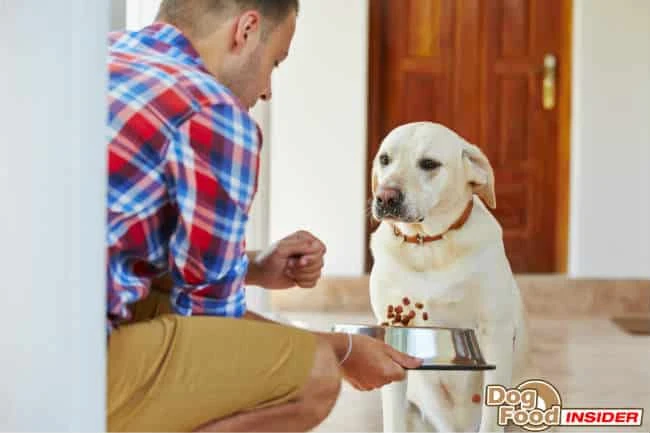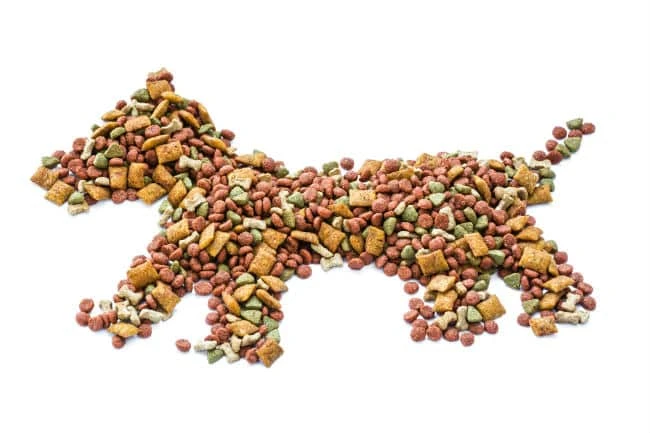Allergy free dog food – A complete guide to hypoallergenic dog food

A Complete Guide to Allergy Free Dog Food…

Sometimes dogs need to be fed an allergy free dog food because surprisingly according to experts dog food allergies make up a massive ten percent of all causes of allergies in dogs. Not surprisingly the first and second most common cause of an allergic reaction in your pooch is due to Fleas and Flea bites and also Atopy (this is a reaction to something that your dog or puppy has inhaled).
There is actually not much research linked to dog food allergies but what is understood is that your dog has become particularly sensitive to something in that specific dog food.
Your dog’s intestinal tract and the antibodies in the intestinal tract will then have a reaction to the agent in the dog food (this is the part of the process that is little understood).
Although certain dog breeds are more likely to suffer from Atopy (an inhalant related allergic reaction) – dog food allergies are not breed or gender specific and can affect any dog, of any age, of any gender.
An allergic reaction to a dog food can occur from the age of five months old into old age. However, the most common age for allergies to develop is between the age of two years of age up to six years of age. As there are so many allergy free dog food recipes currently on the market it is always best to speak to your Vet first as they will have a good idea which is the best.

So what are symptoms of dog food allergies…?
There is no thing as an allergy free dog food but there are dog foods and recipes that make it less likely that your dog will suffer an allergic reaction. Dogs normally develop allergies to specific dog foods over a long period of time.
We get asked many questions in relation to how additives and preservatives can affect your dog – and the bottom line is that they affect dogs just like they do in humans causing a mixture of unpleasant symptoms including..
– Itching and scratching (in fact twenty percent of causes of itching and scratching in dogs is directly linked to a dog food allergy). The itching and scratching will normally affect specific areas of your dog’s body most notably around the anus, face, ears, forelegs and armpits.
– Your dog may also have recurrent and quite serious ear infections.
– Your pooch may start to lose hair.
– Skin infections may also occur.
– Your dog may also poop more often – some studies have found that an average dog will poop around one and a half times a day but a dog that experiences an allergic reaction to a dog food may poop as many as three times in a day.
It is often difficult to distinguish between a dog food allergy and an allergy to something that your dog has inhaled – Atopy. However, with food allergies a recurrent ear infection is more common specifically yeast infections and the allergic reaction will occur all year round as opposed to Atopy.

Below is a Guide to the Best Allergy Free Dog Food…
Cheap manufactured dog food is often heated to such an extent that it causes chemical changes in the food. This will make it more likely for the protein molecules to trigger an allergic reaction.
Manufactured dog food that is cooked at a lower temperature is less likely to cause this chemical change and therefore the protein is less likely to cause an allergic reaction in your dog.
Probably one of the best allergy free dog food inventions is Hydrolysed dog food. This is about as close to an allergy free dog food that you are ever going to encounter. The basis behind this invention is the process of shortening the protein amino acid chain. Due to the science behind the shortening of this chain it will not trigger or start stimulating your dog’s immune system. It is still able to provide the nutrients that your dog needs and should still be tasty enough for your dog to actually enjoy it (remember that dog’s actually prefer the scent of dog food as opposed to the taste) mainly because they have far fewer taste buds but an infinately higher sense of smell.
This type of allergy free dog food has been proven to be so successful that in a recent trial nearly every dog that ate hydrolysed dog food did not have an allergic reaction. Making your own allergy free dog food is another way to prevent your pooch from developing a reaction basically because you are in control of what you put in the recipe.
Here are a list of ingredients that can cause allergies in dogs…
1. Synthetic preservatives, fillers, food dyes and colorings can cause allergy symptoms.
2. Look out for ingredients including Ethoxyquin, BHT, antioxidants and food dyes like Blue 2 and Yellow 6.
3. Allergies develop over a period of time as a consequence of your dog being repeatedly fed the same food.
4. The most common ingredients that cause allergic reactions in dogs include Beef, Chicken, Chicken Eggs, Dairy products, Corn, Soy and Wheat – and guess what – most manufactured dog foods contain these ingredients.
5. Some of the best allergy free dog food recipes will contain Novel Protein sources like Duck, Wild Boar, Venison – although this is not considered a completely allergy free dog food its better than a recipe that contains Beef, Chicken, Eggs etc. Some people think that recipes that only contain Lamb and Rice are an allergy free dog food – this is not the case.
6. Recipes that use novel protein and carbohydrate sources are excellent for dogs that suffer from allergies.
Below is a a list of some of the most popular allergy free dog food available…
Wellness Simple Dog Food – This does not contain any preservatives, fillers, artificial colorings or additives. It uses one unique meat protein and one carbohydrate.
Addiction Raw Dehydrated Dog Food – This food is classed as hypoallergenic and does not contain any additives. Meat used in this recipe includes Lamb and Venison.
Hills Pet Products – Hills produce a range of hypoallergenic and hydrolyzed dog food recipes that use unique protein and carbohydrate sources. Specifically designed for dogs that suffer from food allergies.
Iams – This dog food is also produced using novel protein and carbohydrate sources – great for dogs with allergies.
Purina Veterinary Diet – This product uses novel protein sources and low allergen carbohydrates in the ingredients.
Royal Canin USA – This company produce a range of dog food recipes specifically for dogs with allergies.
References:
Mash, H. 2011. The Holistic Dog: A complete guide to natural health care. The Crowood Press.
The American Animal Hospital Association Encyclopedia of Dog Health and Care, 1994. Quill. New York.
The Doctors Book of Home Remedies for Dogs and Cats. 1996. Rodale Press Inc, Emmaus, Pennsylvania.
Did you know…?

Below we have listed some interesting facts about allergies and how they can be treated.
The most obvious telltale signs that a dog is experiencing an allergic reaction can include some of the following symptoms: a runny nose and/or eyes, vomiting, hivelike swellings on any part of the body (including the head) and lastly diarrhea.
Allergy Test…
If your vet suspects that your pooch is suffering from an allergy then he or she may perform an allergy test. This is quite simple and involves the vet identifying the causative agent and then removing it from your dog’s immediate environment whether this is the ingredient in your dog’s food or something else.
Some ‘Top Tips’ for treating common allergies from home…
1. If your dog is experiencing dry or itchy skin one of the fastest methods of treatment is by spraying your dog’s skin wih cool water. Don’t use warm water otherwise this will make the itching worst.
2. Your dog’s vet may recommend antihistamines such as Benadryl. If the symtoms are more serious then the vet may recommend allergy shots to bring the symptoms under control.
3. Fatty acid supplements are also thought to relieve the symptoms of itching. You can purchase fatty acid supplements from any good pet store. If you purchase capsules and are struggling to get your pooch to swallow them, then the best thing to do is to squeeze the contents (oil) inside the capsule into your dog’s food.
4. If you decide to ease your dog’s itchy skin by giving him or her a bath why not try adding a colloidal oatmeal to the bath water as this makes the water have a silky feel and is great for inflamed and itchy skin.
5. We bet you didn’t know that a dog suffering from an allergic reaction can also get very itchy feet (can you imagine how annoying this would be if you were unable to itch your feet). So why not do it for your pooch. Not only will this help you bond but it will make your pooch feel a whole lot better.
To alleviate the itchy feet (paws) you should purchase some Epsom Salts and dissolve a couple of cups into a shallow bath (there should be just enough water to cover the bottom of the bath). Now just gently lift your dog into the bath and keep her standing in the water for about ten minutes (five if your pooch is getting bothered). Don’t let your pooch drink the water.
Bathing a dog with itchy skin…
Allergy free dog food is classed as ‘hypoallergenic’ which means it is free of nasty ingredients. However, you can also purchase shampoo that is hypoallergenic. Basically a shampoo that has this label means that it is free of dyes and perfumes. If you wanted to go a step further you could purchase an organic shampoo (although this is obviously more expensive).
If you do decide to purchase an organic shampoo for your pooch you need to look for products that are free of Parabens and Sodium Laurel Sulphates as these are chemical preservatives which help to make the shampoo lather. Whatever you choose to wash your dog with it is vital that you rinse all of the residue out of the fur otherwise this will only irritate the skin.
A great method for rinsing the the shampoo and water thoroughly out of the coat is by mixing a cup of chamomile tea with lemon (for lighter colored dogs) and one tablespoon of cider vinegar with a sprig of rosemary for dogs with darker colored coats.




